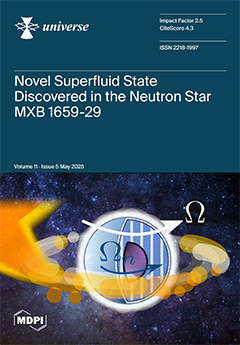We found statistical evidence for a mismatch between the (global) spatial curvature parameter
K in the geodesic equation for incoming photons and the corresponding parameter in the Friedmann equation that determines the time evolution of the background spacetime and its perturbations. The mismatch,
[...] Read more.
We found statistical evidence for a mismatch between the (global) spatial curvature parameter
K in the geodesic equation for incoming photons and the corresponding parameter in the Friedmann equation that determines the time evolution of the background spacetime and its perturbations. The mismatch, hereafter referred to as ‘curvature slip’, was especially evident when the SH0ES prior of the current expansion rate was assumed. This result is based on joint analyses of cosmic microwave background (CMB) observations with the PLANCK satellite (P18), the first year results of the Dark Energy Survey (DES), baryonic oscillation (BAO) data, and at a lower level of significance, the Pantheon SNIa (SN) catalog as well. For example, the betting odds against the null hypothesis were greater than
:1, 1400:1 and 1000:1 when P18+SH0ES, P18+DES+SH0ES and P18+BAO+SH0ES were considered, respectively. Datasets involving SNIa weakened this curvature slip considerably. Notably, even when the SH0ES prior was not imposed, the betting odds for the rejection of the null hypothesis were 70:1 and 160:1 in cases where P18+DES and P18+BAO were considered. When the SH0ES prior was imposed, the global fit of the modified model (that allows for a nonvanishing ‘curvature slip’) strongly outperformed that of
CDM, being manifested by significant deviance information criterion (DIC) gains ranging between 7 and 23, depending on the dataset combination considered. Even in comparison with K
CDM, the proposed model resulted in significant, albeit smaller, DIC gains when SN data were excluded. Our finding could possibly be interpreted as an inherent inconsistency between the (idealized) maximally symmetric nature of the FRW metric and the dynamical evolution of the GR-based homogeneous and isotropic
CDM models. As such, this implies that there is apparent tension between the metric curvature and the curvature-like term in the time evolution of the redshift.
Full article





